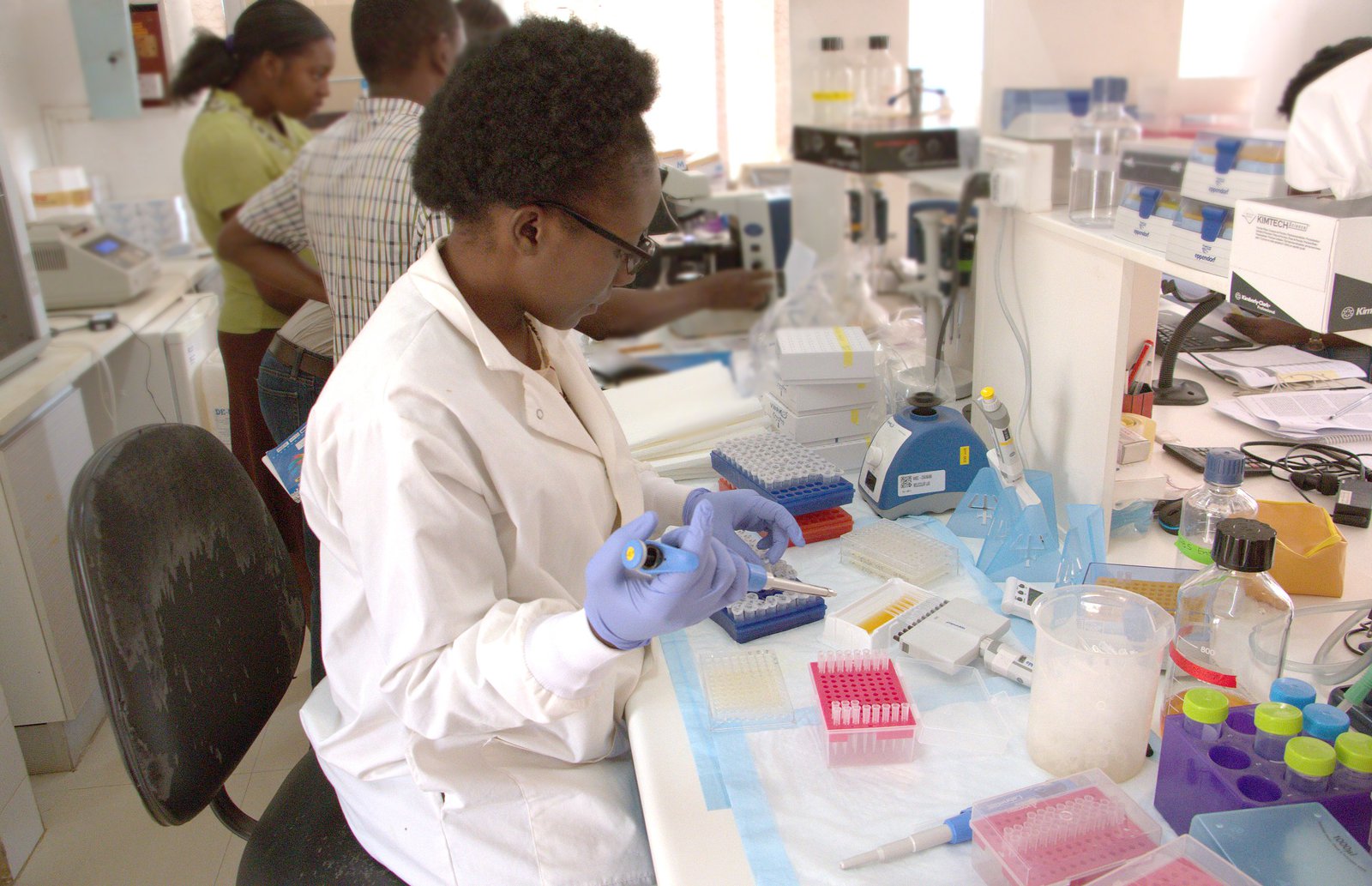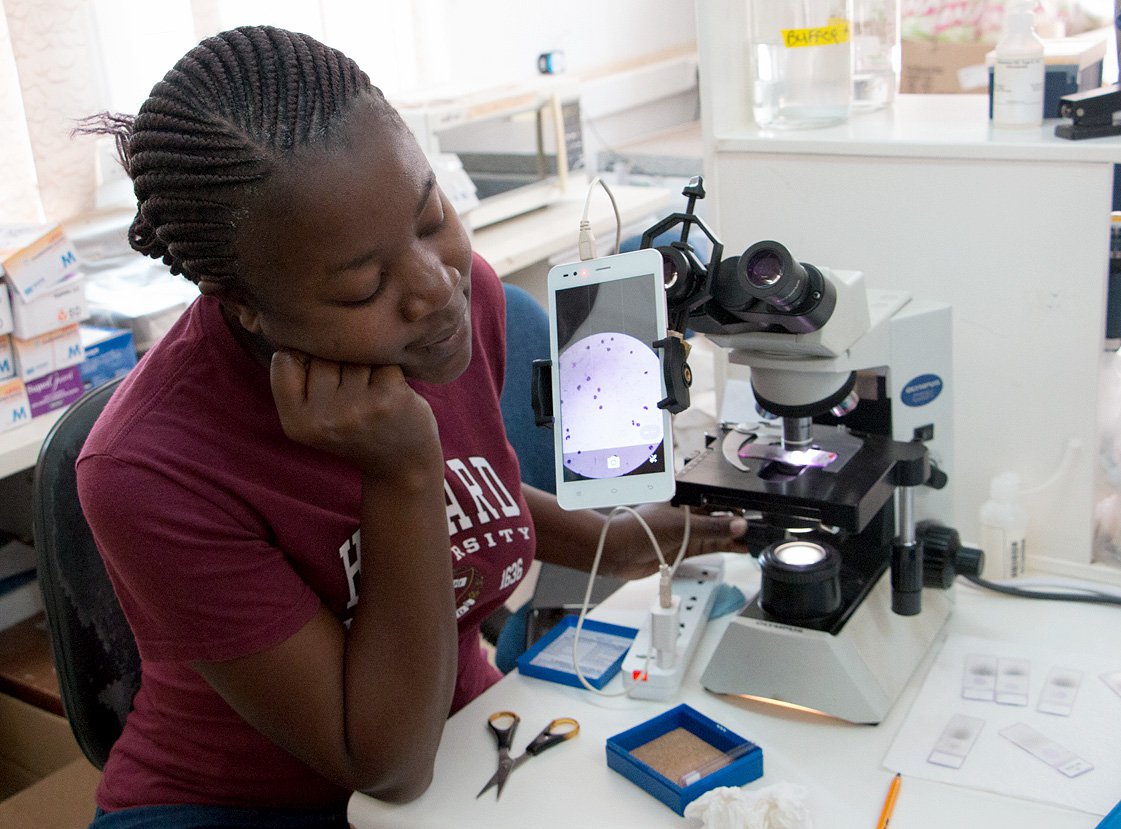In Zambia’s National Malaria Elimination Center, Conceptor, Mulenga, Brenda, Rachael, and Tricia spend their days analyzing, tracking, and fighting the malaria parasite Plasmodium falciparum. For these women, this is more than a job.

Conceptor Mulube conducting an experiment in the National Malaria Elimination Center lab in Zambia. Photo: PATH/Hunter Lengel Isgrig.
A mother’s legacy
For Conceptor Mulube, working in malaria research is deeply personal. “What really pulled me to this kind of work is that my mom died of malaria. The way she died was just in a simple way. Because people detected it late. I thought I should go into this field, work hard, make sure things are done at the right time, and help many others. She was pregnant at the time.”
Conceptor’s mother passed away when she was in 11th grade, soon before taking the exams that would determine whether she could attend university or not. Despite the devastating loss, Conceptor passed the exam and went on to continue her education. “When I finished my grade 12 and when it was time to apply for college, I thought I should do medicine. When I got there, I thought no, it was better to do science. Medicine for me was too general. You do not get to the detail of screening the blood for different parasites, different diseases. If I worked in the lab, I would be able to do that. That’s how I did parasitology and entomology for my degree. Right now, I’m pursuing my master's degree in One Health analytical epidemiology, which also has a component of molecular biology.”
And Conceptor isn’t finished yet; she has goals for her future in research. “I’m hoping to be one of those people who develop assays that are able to discover things in our field. There are a lot of questions that we have. I want to be one of those who answer some of those questions that we have right now.”

Mulenga Mwenda-Chimfwembe, who analyzes blood samples from across Zambia, displays a malaria blood slide on the microscope. The purple dots are white blood cells. Photo: PATH/Hunter Lengel Isgrig.
From sick child to scientist
Mulenga Mwenda-Chimfwembe spent the first ten years of her life continuously sick with malaria. “I grew up in an area where there is very high transmission of malaria in Zambia. Most of my childhood stories include me having serious malaria or cerebral malaria. And among those that survived within my childhood, some had palsy or brain damage from cerebral malaria.”
Mulenga went to school to help children like her and those she grew up with. “The more I studied parasitology and entomology, I started knowing more about diseases. The biggest disease they used to talk about in school was malaria, and to know that I could actually work in malaria and make a difference and sort of strike back at it, that made me excited.”
“To know that I could actually work in malaria…and strike back at it, that made me excited.”
Now, Mulenga spends her days genotyping parasites, looking at their DNA for molecular markers of drug resistance. She also tests blood samples that may have tested negative for the parasite on a rapid diagnostic test in the field, but test “PCR positive” in the lab, meaning DNA indicates the parasites are indeed present, just in low concentrations.

Brenda Mambwe standing in the lab, preparing to conduct an assay on mosquito samples. Photo: PATH/Hunter Lengel Isgrig.
Accelerating the work
Brenda Mambwe leads efforts to streamline the lab’s work using a Luminex® system, a machine that can simultaneously measure many samples. Currently, the variety and number of tests the team runs takes a lot of time and labor—different dissections, assays, and DNA tests for each different variable. Determining the species of a sample mosquito and analyzing its last blood meal are routine experiments that require intensive processes.
The machine could allow the lab to combine (“multiplex”) all the DNA-based tests that it currently performs individually. This would allow the lab to increase the number of samples run per day from 350 to 1,500.
“We’re working on an assay that will detect the species and eventually detect drug resistance in the mosquitoes, and the blood meals. It’s going on well; we’re keeping our fingers crossed, hoping it works out,” Brenda said.
While the molecular approach the lab is taking is not new, the application of it is. Much of the scientific work done on mosquitoes is for smaller entomological studies, so the typical processes aren’t designed for the high-volume demands of surveillance. This is a gap the Luminex project is hoping to address.
“It’s interesting, the Luminex and mosquitoes, we haven’t seen people doing that so far,” said Brenda.

Tricia Hibwato outside the entrance to the lab, which she keeps running smoothly through her work as assistant. Photo: PATH/Hunter Lengel Isgrig.
Keeping it all running
Behind the scenes, Tricia Hibwato keeps the lab going: labeling test tubes, stocking reagents, placing orders. Ensuring there are enough materials at the right times is a major issue for the lab, since many supplies are imported from overseas.
Tricia encountered malaria in her work with the Malaria Control and Elimination Partnership in Africa, helping to conduct the National Malaria Indicator Survey.
“We were in the field, doing a survey and helping out with the lab team. We reached this household and found the child’s temperature was very high. We couldn’t do anything. The malaria was too severe, and the child died in the mother’s arms. It was so painful.”
When Tricia began working in the lab, she wasn’t particularly interested in science. Now, she has dreams of moving into a lab scientist role herself. “I love everything about my job. The cool part is that I get to work in the lab and do all the science with the scientists, which is very fulfilling for me. I would want to be a scientist.”

Technologist Rachael Kasaro in the lab, where she analyzes DNA to determine which species of malaria parasite are present in samples. Photo Credit: PATH/Sarah Anderson.
Growing a career
Lab technologist Rachael Kasaro, the newest member of the team, is focused on growth in her career and has found the National Malaria Elimination Center lab a supportive environment for that.
“I think we are given many opportunities in terms of learning and advancing yourself, to become a better scientist,” she said.
She’d like to see the lab’s work better understood, and would like to improve her own communications skills to do so.
“I would like to be a more well-rounded scientist. Our research needs to be more out there. Many people don’t know what we do exactly,” she said.
As Zambia fights for malaria elimination, these five women work every day to give back, fighting against the parasite that has taken from them. PATH honors them and women like them around the globe who are committed to a better, healthier world.



